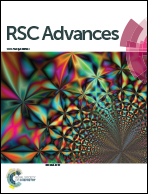Probing the synergism of halloysite nanotubes and electrospinning on crystallinity, polymorphism and piezoelectric performance of poly(vinylidene fluoride)†
Abstract
Poly(vinylidene fluoride) (PVDF) nanofibers have tremendous potential in nano-sensing and energy scavenging applications. In this study, uniaxially aligned nanofibers were developed from halloysite nanotubes (HNT)/PVDF nanocomposite using electrospinning technique. Incorporation of HNT into PVDF not only reduced the diameter of the electrospun nanofibers, but, also improved their morphology. Fourier transform infrared spectroscopy, wide angle X-ray diffraction and differential scanning calorimetry techniques were used to characterize the crystallinity, polymorphism and polymer–filler interaction in the nanocomposite nanofibers. A force sensor was indigenously designed to study the piezoelectric responses of the nanocomposite nanofibers. At 10 wt% of HNT loading, the sensor produced the highest voltage output, which can be ascribed to its highest β-phase content. Incorporation of HNT and use of electrospinning synergistically enhanced the β-phase content and hence the piezoelectric behavior of PVDF. Hence, these nanofibers could be promising and prominent materials in sensor and actuator applications.



 Please wait while we load your content...
Please wait while we load your content...